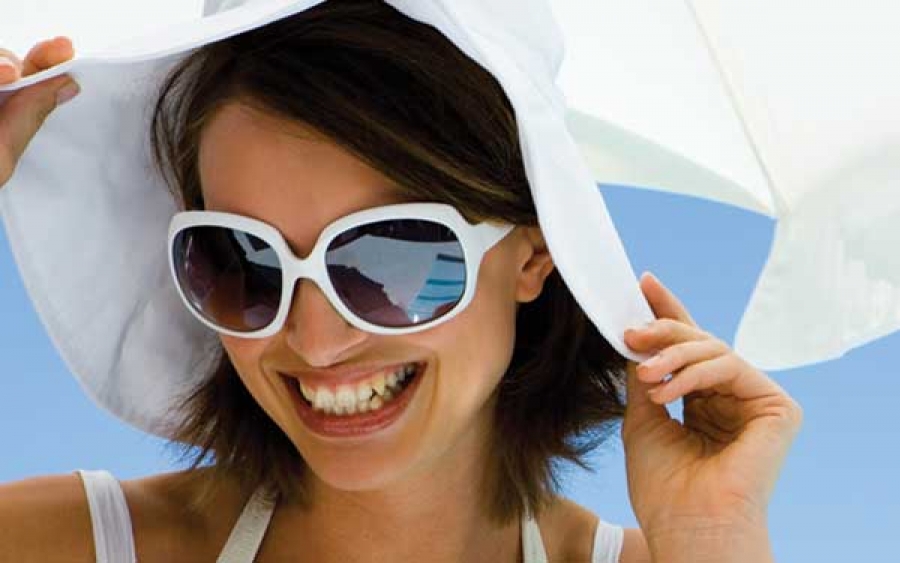The increased prevalence of non-melanoma and melanoma skin cancer makes protecting the body from ultraviolet (UV) irradiation vital to human health. As skin care specialists and providers, what can we do to improve our client’s health? The answer is simple, providing the right skin care regimen with UV protection and antioxidants, along with diet and physical protection recommendations can provide great lengths toward the prevention of damage to the skin and the visible signs of aging.
The Cause
Changes in skin tone, texture, turgor, color, and thickness are all a part of the natural aging process. However, damage inflicted by UV rays and free radicals can be the difference between healthy aging and serious skin conditions. Every individual – skin care professional or not – should understand the primary contributing factors to skin damage. This includes UV rays and free radical damage. According to the Skin Cancer Foundation, UV rays are carcinogenic and the leading cause of nonmelanoma skin cancer (NMSC) and basal cell carcinoma (BCC). Melanoma skin cancer is primarily found in fair-skinned individuals and is also responsible for over 8,000 skin cancer related deaths annually in the U.S.
Of the three forms of UV rays, UVA and UVB are the only two to reach the earth’s surface. Both forms of irradiation contribute to photoaging, DNA mutations, form free radicals, and contribute to immunosuppression in the body. UVB rays are the shorter of the two, having peak hours between 10 a.m. and 4 p.m. and it can be filtered by glass. Until the late 1990s, UVB was thought to be the primary precursor to skin damage and cancer because it contributes to erythema and is carcinogenic. However, modern research has determined that UVA irradiation is also a major contributing factor to DNA damage because it can penetrate to the dermis. Unfortunately, there is no peak time for UVA. With or without clouds, UVA is able to penetrate into the skin and inflict damage.
Free radical damage is a product of both UV irradiation and environmental pollutants in the air. However, free radicals are also found in food, water, alcohol, cigarettes, and prescription drugs (there is no escaping them). In addition, natural metabolic processes within the body create free radicals that have been linked to cell signaling and the immune system to help kill bacteria, but have also been linked to many body diseases, including cancer, diabetes, and arthritis, in addition to aging. The theory of free radical damage and aging involves the migration of molecules that are missing electrons. These unstable radicals migrate through cells in an attempt to become neutral. Like the “domino effect,” as the unstable molecules gain electrons they leave another free radical in its place to scavenge. This damage can contribute to DNA mutations and protein and lipid damage in the cells, thus degradating collagen, thinning the skin, and loss in moisture – the telltale signs of aging of the skin.
Sun Protection
According to the American Cancer Society, there are over one million cases of NMSC and BCC reported annually, with over 62,000 cases of malignant melanoma’s reported. Sun protection is vital to reducing the amount of damage that the skin receives from UV irradiation. The Food and Drug Administration (FDA) has required all sunscreen manufacturers to have a Sun Protection Factor (SPF) rating on all products that make claims to prevent sun damage. However, SPF is not an indication of the amount of protection a product provides, but how long it takes for the skin to burn.
Understanding what ingredients either block or absorb UV irradiation is vital to determining the products protection from both UVA and UVB rays. Ingredients that absorb UV rays help essentially scatter the rays through the excitation of electrons to reduce penetration. On the other hand, UV reflection is the mirror-like effect of reflecting the light away from the body. Sunscreen products labeled as “Broad Spectrum” work against both UVA and UVB rays with the common combination of reflection and absorption. Currently, the strength of protection against UVA is not yet a requirement on package levels with the FDA, but will be in the near future. The European Union requires a star label rating for the amount of UVA protection in a product. Remember, SPF is a measurement of burning (erythema), which is the visible sign of UVB irradiation. The Boots Star System gauges the amount of UVA and UVB that the skin absorbs to determine a product’s protection level and photostability. With both a UVA and UVB rating, sunscreens will become more effective at preventing skin cancer.

Another consideration for sun protection is skin color, age, and care. Basal and squamous cell carcinoma’s and melanoma have higher occurrence rates in Caucasians when compared to African Americans. However, all skin types, dark to light, incur UV radiation damage and the potential for DNA mutations. Protecting the skin with the following key ingredients is necessary to prevent skin damage.
• Aminobenzoic Acid (PABA) - UVB
• Avobenzone - UVA1
• Cinoxate - UVB
• Dioxybenzone - UVB, UVA2
• Ecamsule (Mexoryl SX) - UVA2
• Ensulizole (Phenylbenzimiazole Sulfonic Acid) - UVB
• Homosalate - UVB
• Meradimate (Menthyl Anthranilate) - UVA2
• Octocrylene - UVB
• Octinoxate (Octyl Methoxycinnamate) - UVB
• Octisalate (Octyl Salicylate) - UVB
• Oxybenzone - UVB, UVA2
• Padimate O - UVB
• Sulisobenzone - UVB, UVA2
• Trolamine Salicylate - UVB
• Titanium Dioxide - UVB, UVA2
• Zinc Oxide - UVB, UVA2, UVA1
In order to determine the amount of sun protection that is needed throughout the day, the World Health Organization has created a standardized UV Index scale. This scale ranges from zero to 11 with ranges inbetween that correspond to the amount of UV irradiation the body receives. In Australia, where sun exposure levels are considerably higher than the U.S, there have been UV Index ratings of 17 on some days. Ultimately, the peak time for UV irradiation is at high noon – hence the time zone differences. At high noon you can expect to receive the most amount of UV irradiation and need to protect yourself accordingly. For example, if the local weather forecast displays a level 3 moderate UV Index, the proper protection requirement is sunscreen, protective clothing, and a hat. On those days when it’s nice to wear a tank top, think again.
Application
Sun protection is not part of a once-daily skin regimen. Application and reapplication should be based around an individual’s lifestyle and the amount of sun exposure they may receive. As skin care professionals, many of our clientele receive exfoliation treatments and use alpha- or beta-hydroxy acids in home care products. This exfoliation increases the skin’s sensitivity to the sun and can do more harm than good if the client is not using a sunscreen. In addition, if a client experiences daily sun exposure, they should reapply their sunscreen throughout the day. Because SPF is a measurement of UVB and erythema, what we know about UVB peak time needs to be considered. Reapplication should be more frequent in peak hours and protective clothing should be worn in addition to sunscreen. Cloudy days are no exception. The amount of UVB only slightly diminishes on a cloudy day, but UVA is not affected and still penetrates into the dermis.
It was not long ago when the solid grounds of sun protection were shaken over the discovery of Reactive Oxygen Species (ROS), a form of free radical that may be found in the skin with the absorption of oxybenzone. Although there is concern over oxybenzone as a sunscreen ingredient, it is still widely used because it is a proven absorber of UVB and short-wave UVA rays. The main remedy to prevent the formation of ROS is to reapply sunscreen every two hours. Reapplication will help prevent the formation of ROS and maintain skin protection.
Antioxidants
Natural ingredients in skin care products are generally full of antioxidants if they are at a cosmeceutical level. However, the proven antioxidants that work to protect the skin and deliver results for improved skin appearance, tone and texture are vitamins E, C, and A, lycopene, carotenoids, and alpha lipoic acid. Sunscreens are formulated to protect against UV irradiation, whereas antioxidants exist to neutralize free radicals and prevent cell damage. As mentioned earlier, free radicals cannot be avoided and, in some cases, are a part of the cell signaling process. Both internally and topically they can benefit the skin and help maintain a beautiful skin appearance.
Maintaining an antioxidant rich diet can also prevent oxidative stress and damage in the skin and body. There are a wide variety of rich foods that can prevent oxidative damage from the inside out:
• Polyphenols in green tea
• Flavonoids in dark chocolate
• Carotenoids from lycopene, beta-carotene, lutein, astaxanthin, and zeaxanthin
• Omega-3 Fatty Acids, docosahexaenoic acid (DHA), and eicosapentaenoic acid (EPA)
• Inositol and insitol hexaphosphate from legumes and bran
Maintaining a balanced diet of nutrient rich foods can prevent free radical damage within the body, and thus the free radical theory of aging. Keep in mind that a healthy diet maintains consideration of portions and prevent eating fried fatty foods.
Protecting the skin and body from UV irradiation is a global effort. As skin care specialists, we must support the prevention of skin cancer by providing our clientele with education and insight to protection, awareness, and overall education. After all, sunscreen is the number one anti-aging product and the most important to any skin care regimen. UV irradiation is a direct cause of photoaging, DNA mutations, and immunosuppression. Prevention and education is key to beautiful graceful aging in the future. If you notice any change in a clients skin – including discolorations, lumps or bumps, rough scaly patches and/or changes in the size or shape of a freckle or mole – have them contact a dermatologist immediately.
Reference: www.skincancer.org/understanding-uva-and-uvb.html
 Tina Zillmann is a paramedical aesthetician, having a focus in acne care and light-peeling treatments. She is also the owner of the Skin Rejuvenation Clinique, Inc., a facility that services to pre- and post-operative patients. Zillmann also acts as a national educator for Advanced Rejuvenating Concepts™. Recently, she was the recipient of the Entrepreneur Spirit Award from the National Association of Women Business Owners. She is also the President of Aesthetics International Association (AIA).
Tina Zillmann is a paramedical aesthetician, having a focus in acne care and light-peeling treatments. She is also the owner of the Skin Rejuvenation Clinique, Inc., a facility that services to pre- and post-operative patients. Zillmann also acts as a national educator for Advanced Rejuvenating Concepts™. Recently, she was the recipient of the Entrepreneur Spirit Award from the National Association of Women Business Owners. She is also the President of Aesthetics International Association (AIA).
